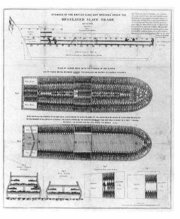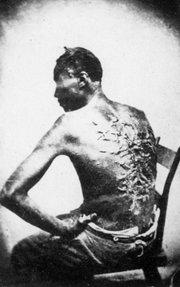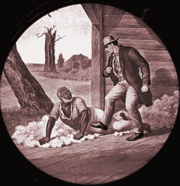History of slavery in the United States
|
|

Slavery, the practice of keeping people in servitude against their will and owning them as property, had a long history in the United States. The first African slaves arrived in present day United States as part of the San Miguel de Gualdape colony, founded by Spanish explorer Lucas V醩quez de Ayll髇 in 1526. The ill-fated colony was almost immediately disrupted by a fight over leadership, during which the slaves revolted and fled the colony to seek refuge among local Native Americans. De'Ayll髇 and many of the colonists died shortly afterwards of an epidemic, and the colony was abandoned, leaving the escaped slaves behind on North American soil. In 1565 the colony of Saint Augustine in Florida became the first permanent settlement in North America, and included an unknown number of African slaves.
Later, English colonization used similar practices, importing 21 slaves from a Dutch frigate to the colony in Jamestown, Virginia in 1619, three of whom are known to have been named Isabella, Antoney and Pedro. Isabella and Antoney had later given birth to a slave boy named William. This "William Tucker" is now considered the first African American born in the English colonies in North America.
Originally, keeping Native Americans and other groups as slaves was tried, but eventually almost all slaves were blacks. During the British colonial period (see History of the United States, Slavery in Colonial America), slaves were used extensively in the Southern colonies, but to a lesser degree in the Northern colonies as well. Early on, the slaves were most useful in the growing of indigo, rice, and tobacco; cotton was only a side crop. Nevertheless, it was clear that slaves were most economically viable in plantation-style agriculture. Many landowners began to grow increasingly dependent on slave labor for their livelihood, and legislature responded accordingly by increasingly stricter regulations on forced labor practices, known as the Slave Codes. Also, to further coerce the slaves into a state of bondage, a method of divide and conquer (e.g. lighter skinned slaves versus those with darker skin) was imperatively used, as such had been redacted from the William Lynch Speech of 1712.
Some of the British colonies placed restrictions on the practice of slavery, others banned it completely, such as Rhode Island in 1774.
The economic value of plantation slavery was reinforced in 1793 with the invention of the cotton gin by Eli Whitney, a device designed to separate cotton fibers from seedpods and the sometimes sticky seeds. The invention revolutionized the cotton-growing industry by increasing the quantity of cotton that could be processed in a day by tenfold. The result was explosive growth in the cotton industry, and a proportionate increase in the demand for slave labor in the South.
Just as demand for slaves was increasing, however, supply was restricted. The United States Constitution, adopted in 1787, prevented Congress from banning the import of slaves before 1808. In that year, Congress acted to ban further imports. Any new slaves would have to be descendants of ones that were currently in the US. One year earlier, British Parliament banned all forms of slave trade within its empire - the United States gained its independence and hence avoided this ban by just a few years.
Historical records indicate that extremely cruel and negligent slaveowners (such as those described by Frederick Douglass) existed alongside kinder slaveowners. These kinder slaveowners provided materially for their slaves and were less inclined to punishment, but they nonetheless denied their slaves the basic rights enjoyed by free people. Not-so-kind slave owners practiced raping black women and children, chopping off the the limbs of slaves who tried to run away, and whipping. During this time white slave owners also started to make a difference in the skin color of the slaves. Darker-skinned slaves worked in the fields, while lighter-skinned slaves or "house negroes" were allowed to work in the house and wore 'civilized' clothing like their slave masters. While essentially all scholars agree that it was a harsh regimen for the slaves, some have noted that the United States slave population was the only slave population in history that actually grew through birth, rather than importation. The interpretation of this fact has been a topic of debate.

Throughout the first half of the 19th century, a movement to end slavery, called abolitionism, grew in strength throughout the United States. This reform took place amidst strong support of slavery on the behalf of the South, who began to refer to it as the "Peculiar Institution" in a defensive attempt to differentiate it from other examples of forced labor. There were several strains of aformentioned reform movements. Some wanted to ship the slaves back to Africa, and settle them in a new homeland there (some also wanted to deport any free blacks in the country); a movement of this type led to the foundation of the modern-day nation of Liberia. Others wanted to simply end the practice of slavery, leaving free blacks in the United States. Another divide was over whether or not slave-owners would be compensated for the value of their lost "property". Whatever the talk was about there was no talk about compensating slaves or considering where the slave would like to live once freed. There was further disagreement over the degree of militancy to use. Some abolitionists, such as John Brown, favored the use of armed force to foment uprisings amongst the slaves, while others preferred to use the legal system.

This movement clashed with slave-owners numerous times throughout the century. The first effort to mediate the two was known as the Missouri Compromise of 1820, an attempt to make sure that the two interests were balanced in the United States Senate. When this fell apart, it was replaced by the Kansas-Nebraska Act of 1854, which led to open battle in the states of Kansas and Nebraska; the period is often referred to as "Bleeding Kansas".
A further split occurred in 1845 with the formation of the Southern Baptist Convention (presently one of the largest Christian congregations in the United States), founded on the premise that the Bible sanctions slavery and that it was acceptable for Christians to own slaves (the Southern Baptist Convention has long since renounced this interpretation). Dozens of Bible verses were used to back up this interpretation. This split was triggered by the opposition of northern Baptists to slavery, and in particular by the 1844 statement of the Home Mission Society declaring that a person could not be a missionary and still keep his slaves as property.
The tensions came to a head with the 1860 election of Abraham Lincoln, who was opposed to the expansion of slavery. Many in the South feared that the real intent of the Republicans was the abolition of slavery in states where it already existed, and that the sudden emancipation of 4 million slaves would be problematic. They also feared that the delicate balance of free states and slave states would be no more and that they would then be under the domination of industrial North with its preference for high tariffs on imported goods. The combination of these factors led the South to secede from the Union and thus began the American Civil War. During the Civil War (in 1863), Lincoln issued the Emancipation Proclamation, which freed all slaves in the Confederate States of America (though not in states which had remained part of the Union). Following the war, the Thirteenth Amendment to the United States Constitution was passed, which officially banned slavery and involuntary servitude in the United States.
See also
Further reading
- Before Freedom When I Just Can Remember: Twenty-seven Oral Histories of Former South Carolina Slaves, Belinda Hurmence, John F. Blair, Publisher, 1989, trade paperback 125 pages, ISBN 089587069X
- Before Freedom: Forty-Eight Oral Histories of Former North & South Carolina Slaves, Belinda Hurmence, Mentor Books, 1990, mass market paperback, ISBN 0451627814
External links
- Born in Slavery (http://memory.loc.gov/ammem/snhtml/snhome.html): Slave Narratives from the Federal Writers' Project, 1936-1938
- Images of slavery (http://www.sonofthesouth.net/Slavery_Pictures_.htm) drawn by Thomas Nast (has background music)de:Atlantischer Sklavenhandel
he:עבדות בארצות הברית pl:Niewolnictwo w USA sk:Hist髍ia otroctva v Spojen齝h št醫och americk齝h
